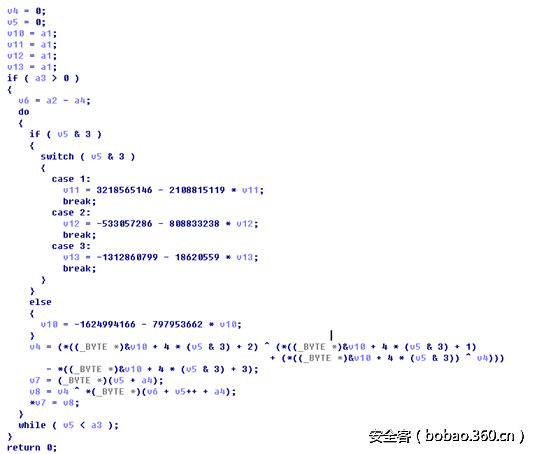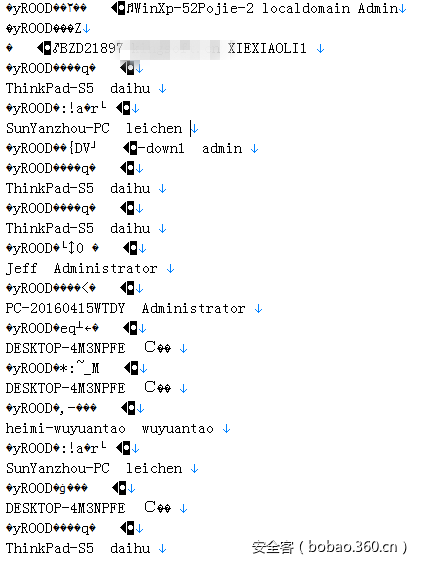XShellGhost通过DNS Tunnel把打点的数据传上去,分析了下编码算法,对数据进行了解密。
编码分析
DNS Tunnel的编码算法是先经过下图的算法1编码;如图:
待编码的数据单字节和一个每4次运算一次的DWORD常量的1,2,3,4字节进行单字节运算来编码,如下:
算法1编码后的数据如下:
然后把结果转换成可见的字符转换方法是通过每个字节的高位加‘j’低位加‘a’,把1个字节拆分成2个字节的可见字符,这样就浪费了一个字节:
解密算法是加密算法的逆运算,解密算法流程如下图:
解密的单条数据的HEX如下:
根据网上的一些公开的流量数据,
解密出的一些上传的数据:
解密代码如下:
int DecodeSecond(int a1, unsigned char* a2, int a3, int a4, unsigned char* szOut)
{
char v4; // cl@1
int v5; // esi@1
unsigned char* v6; // edi@2
byte v7[1024]= {0}; // eax@11
char v8; // dl@11
int v10; // [sp+4h] [bp-10h]@1
int v11; // [sp+8h] [bp-Ch]@1
int v12; // [sp+Ch] [bp-8h]@1
int v13; // [sp+10h] [bp-4h]@1
v4 = 0;
v5 = 0;
v10 = a1;
v11 = a1;
v12 = a1;
v13 = a1;
int i = 0;
if ( a3 > 0 )
{
v6 = a2 - a4;
do
{
if ( v5 & 3 )
{
switch ( v5 & 3 )
{
case 1:
v11 = 0xBFD7681A - 0x7DB1F70F * v11;
v4 = (*((byte *)&v11 + 2) ^ (*((byte *)&v11 + 1)
+ (*((byte *)&v11) ^ v4)))
- *((byte *)&v11 + 3);
v8 = v4 ^ *(byte *)(v6 + v5++ + a4);
v7[i] = v8;
i++;
break;
case 2:
v12 = 0xE03A30FA - 0x3035D0D6 * v12;
v4 = (*((byte *)&v12 + 2) ^ (*((byte *)&v12 + 1)
+ (*((byte *)&v12) ^ v4)))
- *((byte *)&v12 + 3);
v8 = v4 ^ *(byte *)(v6 + v5++ + a4);
v7[i] = v8;
i++;
break;
case 3:
v13 = 0xB1BF5581 - 0x11C208F * v13;
v4 = (*((byte *)&v13 + 2) ^ (*((byte *)&v13 + 1)
+ (*((byte *)&v13) ^ v4)))
- *((byte *)&v13 + 3);
v8 = v4 ^ *(byte *)(v6 + v5++ + a4);
v7[i] = v8;
i++;
break;
}
}
else
{
v10 = 0x9F248E8A - 0x2F8FCE7E * v10;
v4 = (*((byte *)&v10 + 2) ^ (*((byte *)&v10 + 1)
+ (*((byte *)&v10 ) ^ v4)))
- *((byte *)&v10 + 3);
v8 = v4 ^ *(byte *)(v6 + v5++ + a4);
v7[i] = v8;
i++;
}
}
while ( v5 < a3 );
memcpy(szOut, v7, a3);
}
return 0;
}
void DecodeFirst(unsigned char* szText)
{
int iLength = strlen((char*)szText);
int iSubLength = iLength/2;
unsigned char* szXXX = new unsigned char[iSubLength+1];
memset(szXXX, 0, iSubLength+1);
for (int i=0; i<iSubLength; i++)
{
unsigned char One = szText[2*i] - 'a';
unsigned char Two = szText[2*i+1] -'j';
unsigned char Total = One+Two*16;
szXXX[i] = Total;
}
unsigned char* szOutData = new unsigned char[iSubLength+1];
memset(szOutData, 0, iSubLength+1);
DecodeSecond(0, szXXX, iSubLength, 0, szOutData);
printf(" --------------------Decode Data--------------------------------rn");
hexdump(szOutData, iSubLength);
delete [] szOutData;
return;
}
void hexdump(void *pAddressIn, long lSize)
{
char szBuf[100];
long lIndent = 1;
long lOutLen, lIndex, lIndex2, lOutLen2;
long lRelPos;
struct { char *pData; unsigned long lSize; } buf;
unsigned char *pTmp,ucTmp;
unsigned char *pAddress = (unsigned char *)pAddressIn;
buf.pData = (char *)pAddress;
buf.lSize = lSize;
while (buf.lSize > 0)
{
pTmp = (unsigned char *)buf.pData;
lOutLen = (int)buf.lSize;
if (lOutLen > 16)
lOutLen = 16;
sprintf(szBuf, " | "
" "
" %08lX", pTmp-pAddress);
lOutLen2 = lOutLen;
for(lIndex = 1+lIndent, lIndex2 = 53-15+lIndent, lRelPos = 0;
lOutLen2;
lOutLen2--, lIndex += 2, lIndex2++
)
{
ucTmp = *pTmp++;
sprintf(szBuf + lIndex, "%02X ", (unsigned short)ucTmp);
if(!isprint(ucTmp)) ucTmp = '.'; // nonprintable char
szBuf[lIndex2] = ucTmp;
if (!(++lRelPos & 3)) // extra blank after 4 bytes
{ lIndex++; szBuf[lIndex+2] = ' '; }
}
if (!(lRelPos & 3)) lIndex--;
szBuf[lIndex ] = '|';
szBuf[lIndex+1] = ' ';
printf("%sn", szBuf);
buf.pData += lOutLen;
buf.lSize -= lOutLen;
}
}解密工具
链接:http://pan.baidu.com/s/1gfy4ImZ
密码:vugv
参考链接

















发表评论
您还未登录,请先登录。
登录